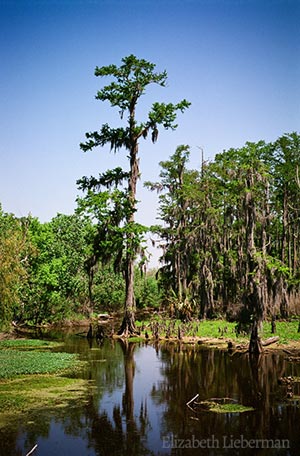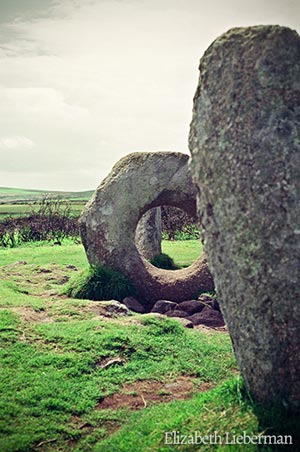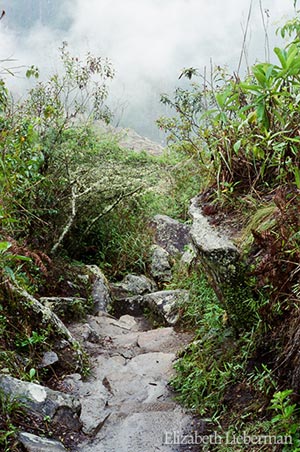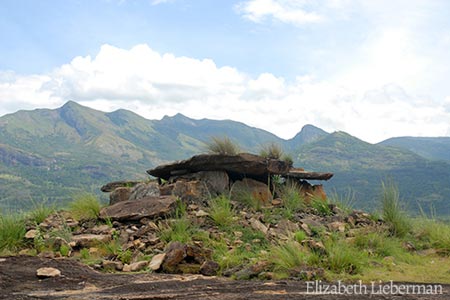It’s true that making field measurements requires physical fitness & technical knowledge, but it also often requires us to look at things from unusual angles.
I have been taking photographs since childhood. For years I have peered at things around me, attempting to capture the sense of them.
In 2010 I had the opportunity to show some of my photographs at an exhibition in California. No extra books from me yet but here are a selection of seven pictures from that exhibition and the stories behind them. Maybe you’ll guess why I called the exhibition “Earth Magic”.
“The Limpid Pool” features a Swamp Cyprus tree on the edge of some water. It’s a scene from a walk Norman & I often take. This swampy area is about 30 minutes by car, away from our home in Louisiana, USA |

The Limpid Pool |
“Fairly Magical” is a study of a fairy-like wild flower growing in the hills around the Simi Valley in Southern California’s Sage brush country. |

Fairly Magical |
|
|
“North Cornwall (UK) Coastline” depicts the sparse rugged beauty and blue waters of the coast of northern coastline of county Cornwall in the UK. I spent many wonderful years living in the Cornwall, it is a lovely county. Replete with ancient megaliths and tin mines to the north, but the southern coastline is completely different and abounds with tiny coves and sandy beaches. |
-Coastline.jpg)
North Cornwall (UK) Coastline |
“Men-an-Tol as seen from the NW” is a megalithic monument in county Cornwall UK. This megalith comprises three large stones: two pillars and a circular stone with a hole at its centre, all placed in line with each other. Most of the pictures you will see of this monument show all three stones from left to right across the picture; I recorded it that way too. Intriguingly the alternate view from the South East taken on the same day within minutes of the view (seen here) from the North West, is all sunshine, blue skies and puffy white clouds! |

Men-an-Tol as seen from the NW |
|
|
“Friends & Family” is a collection of Peruvian carrying blankets that I brought back from the first trip that Norman & I made to Peru. I gave the blankets away to friends and family members, but the colours were so vibrant and the weave so intricate that I just had to photograph them all together before I parted with them. Now as I look at the picture and see each individual blanket I’m remembering each person that the blankets went to, and often think about my two friends who have since moved away from Metairie but who were my fellow “storm runners” on the exodus from New Orleans the day that Katrina came calling in 2005. |
|

Friends & Family |
|
“The Inca Trail to Machu Picchu” is the picture that persuaded me to obtain a digital camera. There was I at one of the world’s most fantastic places – “Machu Picchu” no less…..here’s what happened: Norman & I had just completed the lengthy guided tour & had 20 minutes to ourselves before the ‘bus left to take us back to the rail head at the foot of the mountain where the train awaited to take us back to Cuzco. But in all the time I’d been there on “the tour”, I still hadn’t found the place to stand from whence to take

The Inca Trail to Machu Picchu |
“The Picture” of “The View” that one always sees of Machu Picchu in all the guide books and magazines. Our guide suggested various activities for our 20 minutes free time such as “you might like to climb the 100+ steps to the observatory,” or, “you might like to walk up the hill over there to where the Inca Trail comes in to Machu Picchu.” I decided against the observatory and went to look at the Inca Trail. Wonder of wonders, there before me was “The View”! Except being at such a high elevation it was so misty that a clean shot was impossible. “Oh well,” I thought, “might as well walk back up the trail for a few minutes, then turn and walk back. Maybe, at some point there’ll be a magic shaft of sunlight or something so as to make the perfect picture, it certainly can’t get any worse.” After I turned back toward Machu Picchu I took the picture that you see here, showing part of the Inca Trail with the ancient ruins of Machu Picchu in the misty blue distance. I thought that I then locked my camera shutter before continuing on back down the trail. But I was wrong about that. After a couple of minutes I saw two more tourists heading up the trail towards me, so I side stepped so as to let them pass. But as I regained my balance on the edge of a tree root I heard the unmistakable “whirr-click, whirr-click” of my camera - Aaargh ! My camera shutter was not locked off after all! The camera had just clicked through the last two frames on my last roll of 35mm film!!! |
“The Dolmens od Marayoor II” is one of a series of pictures. Marayoor is another of planet Earth’s fantastic locations, but this one is in Kerala, Southern India.
 The Dolmens od Marayoor II The Dolmens od Marayoor II |
Generally speaking when Norman & I visit India our clients keep us too busy for sight seeing – but occasionally our clients let us loose. Initially my plan was simply to take pictures of spices growing in the southern part of India but at the last moment as I rummaged through Wikipedia trying to answer the question “What would you like to see?” that our hosts had asked us, I discovered that high in the hills of that region there were megalithic monuments, dolmens of the same type as those in Cornwall (UK) and in regions of France and Spain. The site of these dolmens in Marayoor is a little off the beaten tourist track, our driver had to ask directions several times. (No sane westerner would attempt to drive in India, it takes courage and years of practice.) One enters the site beside a high school and then there is a walk and eventually some clambering up a steep bare granite hillside, but it is well worth the climb. We passed are a couple of megalithic tombs at the base of the hill but at the top of the hill, spread out before us was a veritable village of dolmens. I have never seen anything like it. In my previous experience a dolmen would be an isolated singular structure of typically three upright stones and a cap stone set in breathtakingly beautiful scenery, but the group of three shown in this picture are just one group of many spread out across the tops of the hills behind the school at Marayoor.
The dolmens of Marayoor are reputed to be much, much older than those in Britain. I was therefore left with the inevitable question “Who taught who?” as I pondered the striking similarity between dolmens in Cornwall (particularly Chun Quoit and Mulfra Quoit), and the dolmens of Marayoor.
|
|
|


